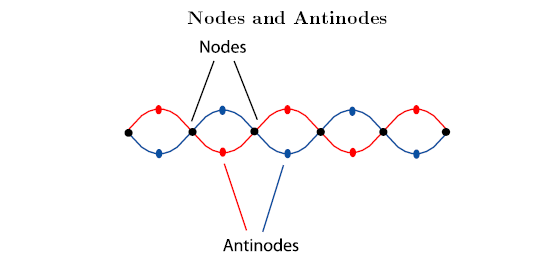You may have noticed an interesting thing in the animation (pg 101) of standing waves: there are spots where the "water" goes up and down a great deal, and other spots where the "water level" doesn't seem to move at all. All standing waves have places, called nodes, where there is no wave motion, and antinodes, where the wave is largest. It is the placement of the nodes that determines which wavelengths "fit" into a musical instrument "container".

One "container" that works very well to produce standing waves is a thin, very taut string that is held tightly in place at both ends. (There were some nice animations of waves on strings available as of this writing at Musemath.) Since the string is taut, it vibrates quickly, producing sound waves, if you pluck it, or rub it with a bow. Since it is held tightly at both ends, that means there has to be a node (pg 103) at each end of the string. Instruments that produce sound using strings are called chordophones14, or simply strings.

The fundamental wave is the one that gives a string its pitch. But the string is making all those other possible vibrations, too, all at the same time, so that the actual vibration of the string is pretty complex. The other vibrations (the ones that basically divide the string into halves, thirds and so on) produce a whole series of harmonics. We don't hear the harmonics as separate notes, but we do hear them. They are what gives the string its rich, musical, string-like sound - its timbre. (The sound of a single frequency alone is a much more mechanical, uninteresting, and unmusical sound.) To find out more about harmonics and how they affect a musical sound, see Harmonic Series.
Exercise 3.1:
When the string player puts a finger down tightly on the string,
- How has the part of the string that vibrates changed?
- How does this change the sound waves that the string makes?
- How does this change the sound that is heard?
- 5978 reads






